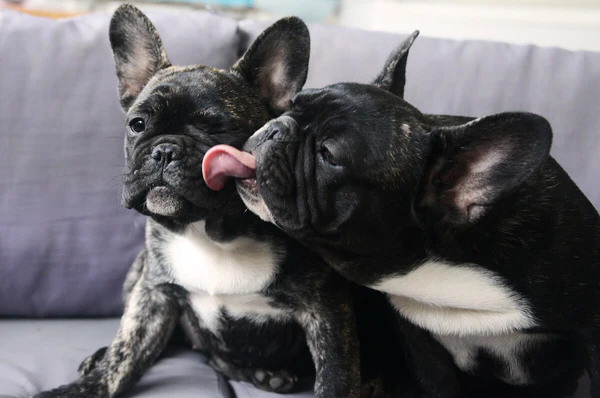French Bulldogs are not hypoallergenic. In simple terms, hypoallergenic means fewer allergens, not zero. If you’re sensitive, that difference matters.
Frenchies shed a little all year. They also produce dander and saliva proteins that can trigger allergies. Reactions vary by person, but this breed isn’t a low-allergen pick.
This guide will help you cut allergens at home with smart cleaning, grooming, and air filtration. You’ll learn how to test your reaction before adopting, including safe meet-and-greets and home trials. We’ll also share breeds that may be easier for allergy‑prone families, plus practical next steps.
By the end, you’ll know what to expect from a Frenchie in an allergy picture, how to reduce flare-ups, and when to consider other options. Clear facts, simple steps, and real solutions for living well with allergies.
Are French Bulldogs hypoallergenic? The clear answer and why it matters
No, French Bulldogs are not hypoallergenic. Hypoallergenic means a dog is less likely to trigger symptoms, not allergy free. All dogs release allergen proteins in skin flakes (dander), saliva, and urine. Coat type and hair length do not remove allergens, hair only carries them from place to place. Frenchies have a single, short coat, shed moderately all year, and still spread allergens on fabric and in the air. If your allergies are mild, strict routines may help. If your allergies are moderate to severe, a Frenchie is usually not a good fit. Up next, you will see how allergens work, why Frenchies are risky for sensitive people, and safer next steps.
What hypoallergenic really means for dog lovers
Hypoallergenic means lower risk, not zero risk. It signals fewer allergens shed into your home, but you can still react.

The main dog allergens come from proteins that stick to dander, saliva, and urine:
- Can f 1: a common dog allergen found in skin and saliva.
- Can f 5: a prostate-related protein, often a trigger for some people, carried in saliva and urine.
Key points that keep expectations realistic:
- No breed is 100 percent hypoallergenic. Some produce fewer airborne allergens, but none are allergen free.
- Hair does not equal allergen. Proteins cause the reaction, hair only moves them around.
- Simple example: a cream Frenchie and a black Frenchie shed the same proteins. Color does not change allergens, and short hair does not cancel them.
For a quick reference on breed expectations, a veterinary guide also confirms that French Bulldogs are not hypoallergenic. See this overview: French Bulldog Guide: Before You Get One in 2025.
Why Frenchies are not hypoallergenic
French Bulldogs have a single, short coat. They shed at a moderate level all year. Short hair still carries dander and dried saliva, and it clings to sofas, rugs, and car seats.
Skin health matters. Frenchies have skin folds and sensitive skin. If folds trap moisture or get irritated, the skin can flake more, which adds airborne dander. Routine cleaning and drying of folds keeps flakes down, but it does not remove allergens.

Saliva is a fast trigger. Frenchies drool, lick faces, and groom their paws, then touch furniture and people. That transfers saliva proteins. If you are sensitive, face licking can flare symptoms around your mouth, eyes, and nose within minutes.
If you want a second viewpoint that aligns with this, review this plain-language breakdown: Are French Bulldogs Hypoallergenic?.
Quick verdict for allergy sufferers
Match your plan to your sensitivity:
- Mild allergy: You can try strict routines. Bathe and brush on a schedule, wipe paws and folds, wash bedding hot, vacuum with a HEPA filter, and run an air purifier in common rooms.
- Moderate allergy: Test first in real life. Spend several hours in a Frenchie home, then try a foster or multi-day trial. Track symptoms for 48 hours.
- Severe allergy or asthma: Pick a different breed with lower allergen spread, or skip dogs for health. Your lungs come first.
If you are unsure, speak with an allergist for testing and a plan tailored to your triggers.
Allergens and shedding in French Bulldogs: what to expect day to day
Living with a Frenchie means managing a steady trickle of hair and allergen proteins. Short hair does not stay put, it sticks to fabric, rides dust, and moves through your home on air currents. With a plan, you can cut the load, but you cannot remove it fully.
Shedding facts: coat type, seasons, and normal vs. excess
French Bulldogs have a single, short coat. They shed lightly all year, with small upticks in spring and fall. Expect brief spikes again after stress, illness, or a diet change. These are typical patterns for the breed and match what you will see in most homes.
Normal shedding shows up as:
- Short, stiff hairs on dark clothes after a cuddle.
- Fine hairs on the couch arms, throw blankets, and car seats.
- A light halo of hair on sheets and pillowcases after sleeping together.
You should not see bare patches or clumps coming out in your hand. Warning signs that need a vet visit include:
- Bald spots, thinning, or moth-eaten areas.
- Red, oily, or flaky skin, with a sour or yeasty odor.
- Intense itching, constant paw chewing, or head shaking.
These can point to mites, fleas, allergies, or infection. For a quick primer on baseline shedding patterns, review this summary of shedding in French Bulldogs.
Dander, saliva, and indoor air quality
Dog allergens live in tiny skin flakes and dried saliva. They hitch a ride on shed hair and dust, then float into the air when you sit down, fluff a pillow, or vacuum without a HEPA filter. That is why a quick clean can sometimes make you sneeze.
Soft surfaces hold more allergens than hard floors:
- Upholstery, rugs, curtains, and pet beds act like sponges.
- Smooth floors, leather, and wipeable surfaces release less and clean faster.
HVAC systems and fans pick up these particles and recirculate them. You can lower the overall load with HEPA air purifiers, regular vacuuming with a sealed HEPA machine, and fresh air when weather allows. These steps reduce exposure, but they do not erase allergens.
Skin problems that raise allergen levels
Frenchies are prone to skin issues that increase flaking and odor, and that means more airborne allergens. Early treatment keeps skin calm and allergen spread lower.
- Atopic dermatitis: Environmental triggers inflame the skin, causing itching and more dander.
- Yeast or bacterial infections: Moisture in skin folds fuels overgrowth, leading to smell, redness, and extra shedding.
- Fleas or mites: Bites and burrowing trigger intense scratching, hair loss, and scabs that flake.
- Food reactions: Some proteins drive chronic itch and ear problems, which worsen shedding and skin debris.
If you notice irritation, see your veterinarian for diagnosis and a plan. Consistent parasite control and fold care make a big difference. For a vet-backed overview of common Frenchie skin problems, read this guide on French Bulldog skin conditions and care.

Myths vs. facts about Frenchie allergies
- Myth: Short hair equals hypoallergenic. Fact: All dogs make allergen proteins, and short hair still spreads them.
- Myth: Certain colors shed less. Fact: Coat color does not change shedding or allergens.
- Myth: Special shampoos make a dog hypoallergenic. Fact: Medicated or moisturizing shampoos calm skin, they do not remove allergens.
- Myth: Puppies will not trigger allergies. Fact: Puppies make the same proteins as adults, and reactions can start fast.
Allergy-friendly care plan: reduce dander without giving up your Frenchie
You can keep your Frenchie and breathe easier with a steady routine. Focus on three fronts, the dog, the air, and your surfaces. Done together, these steps lower allergen load. They reduce symptoms, they do not erase them, so consistency is everything.
Weekly grooming that actually helps
Start with a short, repeatable plan that clears loose hair, dander, and saliva from the coat.
- Brush 3 to 4 times per week with a rubber curry or grooming glove. Work in short strokes, then wipe the coat with a damp microfiber cloth to collect fine dust. Keep sessions to 5 to 10 minutes.
- Bathe every 3 to 4 weeks with a gentle, fragrance-free shampoo. Rinse well until water runs clear. A long rinse matters, leftover suds can irritate skin and raise flaking. Some sources report allergen-reducing baths can cut dander levels, see these tips on reducing pet allergens at home.
- Fold care, clean and dry daily if your Frenchie has deep facial folds and a tail pocket. Use pet-safe wipes or a soft cotton pad, then pat dry to prevent moisture buildup.
- After walks, wipe paws, belly, and coat with pet-safe wipes to remove outdoor pollen and dust. A quick wipe at the door prevents tracking allergens to the couch.
- Dry fully. Moisture can fuel yeast or bacteria, which increases odor and flakes.
Sample weekly routine:
- Mon, Wed, Fri, quick brush and damp cloth wipe.
- Daily, fold clean and dry, paw and belly wipe after walks.
- Every 3 to 4 weeks, full bath and thorough rinse.
Cleaner home, cleaner air
Lower what your nose meets in the air and on fabric. Small, steady habits beat occasional deep cleans.
- Run a HEPA air purifier sized for each room you use most. Check the CADR and match it to room square footage. This helps capture tiny allergen particles.
- Use MERV 11 to 13 HVAC filters and replace on schedule. Set a calendar reminder so it never slips.
- Vacuum twice a week with a true HEPA, sealed-body vacuum. Go slow on rugs, upholstery, and baseboards where dust collects.
- Wash dog bedding, throws, and frequently used blankets hot, weekly. Dry on high heat when fabrics allow.
- Use removable couch covers so wash day is easy. Keep extra covers on hand.
- Keep clutter low to reduce dust traps. Choose tight-weave fabrics over knits and chenille.
- Make the bedroom pet-free. Your lungs need a nightly break, and sleep quality often improves.
For extra setup ideas that reduce dander build-up, review these practical home tips from the AKC on making a dog-filled home comfortable for guests with allergies.
Health and diet support for better skin
Healthy skin sheds fewer flakes. Partner with your vet and keep changes simple.
- Ask your vet about omega-3 fatty acids to support the skin barrier. EPA and DHA often help reduce dryness and irritation.
- If itch or redness persists, discuss prescription anti-itch meds. Controlling inflammation cuts scratching and flaking.
- Use year-round flea control. One bite can start a full-body itch cycle that raises dander.
- Do regular skin checks. Look for redness, odor, oily buildup, or hot spots, especially in folds, ears, and the tail pocket.
- Keep the diet stable. Avoid random food switches without guidance. If food sensitivity is suspected, use a vet-led elimination plan.
For a bulldog-focused look at managing itch and allergy flares, see this vet resource on itch allergies in Bulldogs and French Bulldogs.
Handle saliva and close contact wisely
Saliva carries allergen proteins, and Frenchies love to be close. A few guardrails help a lot.
- Wash hands after play, training, and tug. Keep unscented wipes by the door.
- Limit face licking. Train a “kiss-free” greeting and reward calm sits instead.
- Keep a small towel handy to wipe drool from the muzzle and chest.
- Choose leather or tight-weave furniture that wipes clean. Skip heavy knits that hold saliva and hair.
- Line car seats with washable covers. Shake outside, then launder hot each week.
- Brush the dog outdoors when possible. If indoors, brush near an air purifier on high and vacuum after.
Small actions, done daily, stack up. Combine grooming, clean air, smart surfaces, and skin care, and you will cut your exposure without giving up your Frenchie.
Not sure yet? Test your reaction and consider lower-allergen breeds
If you are undecided, test in real life before you commit. Short, structured trials can show how your body responds to a Frenchie, and medical testing can confirm triggers. You can also meet breeds that tend to shed fewer airborne allergens. The goal is to get clear data so you choose a dog you can live with comfortably.

Try-before-you-adopt plan
A simple, repeatable plan will give you useful signals.
- Schedule two or three visits to a home with a Frenchie. Stay for 2 to 4 hours, on different days.
- Wear your usual clothes, and skip antihistamines during tests unless your doctor tells you to keep them. You want a real read on your baseline response.
- Borrow a used dog blanket or bed cover. Place it on your couch and on your bed for 48 hours. Use the items as normal so allergens contact your skin and fabrics.
- Track reactions in a notebook. Log time, place, activity, and symptoms. Note sneeze count, itch, eye redness, wheeze, hives, or chest tightness.
- Repeat if needed. Consistent symptoms after separate exposures point to a higher risk at home.
Helpful cues:
- Fast reactions: sneezing, itchy eyes, or hives within minutes often come from saliva or dander contact.
- Delayed reactions: congestion or cough a few hours later can follow heavier exposure on soft surfaces.
If symptoms spike, stop the trial and speak with your doctor.
Allergy tests and treatment options
Two common tests can confirm a dog allergy:
- Skin prick test: A tiny drop of dog allergen goes on your skin, then the surface is gently scratched. If you are allergic, a small itchy bump appears in about 15 minutes.
- Blood IgE test: A lab measures allergy antibodies in your blood to dog proteins. This is helpful if you cannot stop medications or have skin conditions.
An allergist can review your history, confirm dog allergy, and build a plan. Options include non-drowsy antihistamines, nasal sprays, eye drops, and asthma control if needed. Allergy shots (immunotherapy) can reduce symptoms for some people, but they take time and regular visits. For a plain-language overview of diagnosis and treatments, see the Mayo Clinic guide on pet allergy diagnosis and treatment.
Breeds many allergy sufferers tolerate better
No dog is zero allergen, but some breeds tend to spread fewer allergens into the air. Many people do better with:
- Poodle (toy, miniature, standard): Tight curls, very low shedding.
- Portuguese Water Dog: Wavy or curly coat, low shed when groomed.
- Schnauzer (mini and standard): Wiry outer coat, regular stripping or clipping helps.
- Bichon Frise: Soft, curly coat that holds loose hair until brushing.
- Soft Coated Wheaten Terrier: Silky single coat, needs steady care to avoid mats.
Results vary by person. Always meet the exact dog you plan to bring home. Regular grooming still matters, even for these breeds. For a broad reference list, the AKC summarizes options in its guide to hypoallergenic dog breeds.
Adoption and return policies that protect your health
Protect your health and your heart by setting up safety nets ahead of time.
- Ask about trial stays or foster-to-adopt programs. A week or two in your home often reveals real patterns.
- Confirm a return window with clear timelines and any fees. Some rescues offer 7 to 30 days, responsible breeders often allow returns at any time.
- Get terms in writing. Include what happens if allergies worsen and who covers transport.
- Prepare allergy supplies before the dog arrives. Stock antihistamines approved by your doctor, nasal spray, a HEPA air purifier, washable covers, and a sealed HEPA vacuum.
If your symptoms are moderate to severe, or asthma flares despite these steps, walk away and choose a different breed or no dog. Your breathing and sleep come first.














Leave a Reply